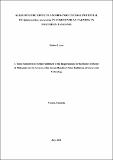| dc.description.abstract | Weeds and insect pests are amongst the serious constraints in common bean farming in most
parts of Tanzania. However, weeds with allelopathic and insecticidal properties if well
manipulated can be used to manage insect pests, weeds and other challenges in agriculture.
Therefore, this study assessed the allelopathic effects of a weed Sphaeranthus suaveolens in
common bean seed germination and seedling growth, as well as its bio-insecticidal potential in
managing Acanthoscelides obtectus, an insect pest of stored legumes. Social survey to
smallholder farmers in Arumeru and Moshi rural districts, seed germination and post-harvest
loss experiments, as well as the phytochemical screening of secondary metabolites were
conducted in order to gather local knowledge on weed and insect pest management practices,
assess the allelopathic effects of different concentration of S. suaveolens crude extracts,
evaluate the bio-insecticidal properties and identify the secondary metabolites present in S.
suaveolens crude extract. Results showed that, insect pests and weeds were the main constraints
in common bean farming and chemical spray and mechanical weeding were the main methods
used by farmers to manage them respectively. Furthermore, S. suaveolens in the surveyed
villages was more distributed in farmlands and swampy areas and density was high during the
rainy season. Results further showed that seed germination, seedling growth and chlorophyll
content of common bean seedlings were significantly affected by the high concentration of S.
suaveolens crude extracts which suggests the presence of water soluble allelochemicals.
Moreover, the mortality of A. obtectus in common bean seeds treated with high dose of S.
suaveolens powder was higher compared with the control experiment, signifying the
insecticidal properties of S. suaveolens powder and its potential in managing A. obtectus in
storage facilities. Additionally, the phytochemical analysis of S. suaveolens crude revealed the
presence of terpenes, alkaloids, flavonoids, saponins, glycosides, steroids and anthraquinones.
Thus, the findings from this study showed the allelopathic effects of S. suaveolens extracts on
common bean seed germination and growth, as well as potential of its powder in managing A.
obtectus in storage facilities thereby reducing post-harvest loss particularly among smallholder
farmers with limited access to synthetic pesticides. | en_US |

